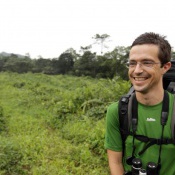Molecular biogeography and conservation of Africa’s highland forest birds
Highland forests are arguably the most diverse and threatened habitats in Africa, at risk due to their restricted areas, nested within regions with large human population densities, and their predicted susceptibility to climate change.
The similarities and differences in these highland avifaunas have long fascinated ornithologists, but the development of biogeographic hypotheses has been hindered by the lack of phylogenetic information for the avifaunas of several important centres. Recent research has discovered numerous new species among the relatively well-studied East African montane forest birds, but important areas such as the Angolan Scarp and northern Mozambique highlands have been largely ignored due in part to recent political instability.
The ultimate aim of this project is to provide novel insights into the biogeography of birds found in the highlands of tropical Africa by inferring, for the first time, the evolutionary links between all highland regions. In parallel with this we aim to provide clear guidelines for conservation planning and to launch specific conservation actions in the most threatened areas.
The initial phase of the project focuses on the Angolan highlands. This very important centre of bird endemism is of particular interest for including the most isolated ‘islands’ of the Afromontane ‘archipelago’. Since 2008, we have been carrying out fieldwork to: i) obtain appropriate genetic material for phylogenetic and phylogeographic studies, and to ii) update information on the distribution, abundance and habitat associations of the least known and threatened species. We shall use molecular tools to identify units of biodiversity among birds, and to infer the historical processes that resulted in the evolution of current diversity. This information will be combined with the assessment of the present situation in order to draw up informed conservation targets. In 2009, we launched a conservation programme for the Afromontane forests at Mount Moco, the highest mountain of Angola where the best remnants of this habitat persist. In 2010, we will start a conservation programme for the forests of the central scarp of Angola, where the bulk of the endemic bird species of Angola are confined to. In late 2010, the first expedition to the forests of northern Mozambique will also take place.
